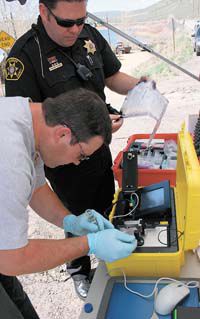| Deputy Richard Boyden reviews information while Zac Palacios of the local HAZMAT unit places a sample on the plate of an analysis machine after an apparent oil spill was reported last Thursday at Scofield Reservoir. Responding to a public safety dispatch broadcast on May 10, HAZMAT crew members from Price and Helper tested the substance on the county’s analysis equipment. The analysis determined that the material collected from the reservoir was organic in nature, probably algae. |
A reported oil spill in Scofield Reservoir on May 10 turned out to be a natural occurrence.
Last Thursday afternoon, public safety dispatchers notified HAZMAT officials that the center had received a call reporting what appeared to be an oil slick on Scofield Reservoir.
Emergency personnel assembled at Helper’s fire station, picked up the county’s HAZMAT vehicles and headed for Scofield.
“The initial reports were unclear and, at first, we thought it might have been a vehicle in the reservoir,” said Jason Llewelyn, HAZMAT specialist. “All I could imagine was something with a lot of fuel or oil in it in the lake, leaking thousands of gallons of petroleum into the water.”
The majority of the county’s water supply comes from Scofield and oil, gasoline or diesel fuel leaking into the reservoir could be a major catastophe.
According to the National Oceanic and Atmospheric Administration, a few quarts of oil can pollute up to one million gallons of water and make it unusable for drinking.
Cleaning up oil spillsIf an oil spill were to occur at a local reservoir, the National Oceanic and Atmospheric Administration has developed procedures for cleaning up the mess. |
Llewelyn and Gary Harwood were the first county responders to arrive at the scene. Approaching on Utah Highway 96, they spotted what appeared to be a barrel on the shoreline and an oil slick on the lake. But after reaching the site, Llewelyn determined there was no oil slick and the barrel was a boat dock float.
Scofield State Park officials at the scene told Carbon HAZMAT personnel that the slick appeared to be an algae that naturally occurs in the lake at times.
Park officials said the wind had been blowing from the northwest for a few days. The errant dock float and algae had apparently gathered at that point on the lake.
After the county’s analysis equipment arrived at the scene, samples were taken and tested.
The analysis confirmed that the samples contained water and organic materials, probably algae.

